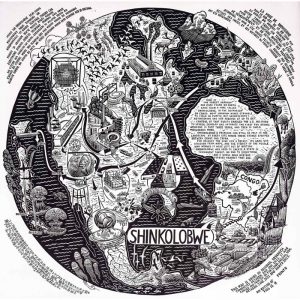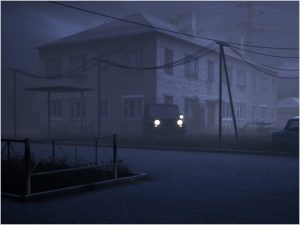Last year, the UK government announced their plan to build new nuclear power stations in 11 locations in England and Wales in order to meet their CO2 emission targets. Nuclear offers a clean, near limitless energy solution that could allow the UK to meet its emission targets without having to moderate consumer’s access to energy. The broad public however is everything but prepared to accept the move. Over the past few years, science have failed to assuage the public’s unscientifically-based fears and sometimes irrational concerns over nuclear energy.

With his speculative proposal Nuclear is good. What will it take to convince you?, Oliver Goodhall is trying to shape convincing arguments in favour of nuclear energy. The project is in no way propaganda, it’s more about opening up a debate about nuclear energy and energy policy in general. The video below gives a clear overview of Oliver Goodhall’s project:
One of the outcome of Goodhall’s research was walking and talking tour to the site of a potential power station in Bradwell-on-sea, in Essex, England. He enrolled nuclear engineers, environmentalists and designers to have a nuclear-theme picnic with plenty of mushrooms and toxic-looking icecream but more importantly, to exchange views about nuclear energy in a way that would not have been possible had the encounter taken place in an office meeting room.
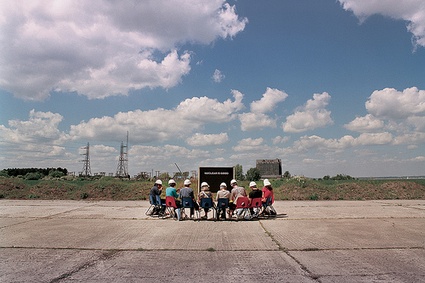
Among some of Oliver’s proposals is a protective barrage cloud hovering over the power station to respond to fears of a disaster incident that would release radiation into the atmosphere; benefits to citizens for accepting to take responsibility of their individual nuclear waste; a special emergency team always on call to intervene in case of a problem at the power station, etc.
What if we ask for protective barrage balloons, establish concrete emergency services and resign ourselves to the perceived ‘hazards’? What if we embrace pet polar bears and pineapple ice cream along with other benefits that nuclear energy could bring? And what if not; are we prepared for blackouts instead?
After having watched the video for the project and seen Oliver’s works at the Design Interactions show last June, i still needed to ask him a couple of questions:
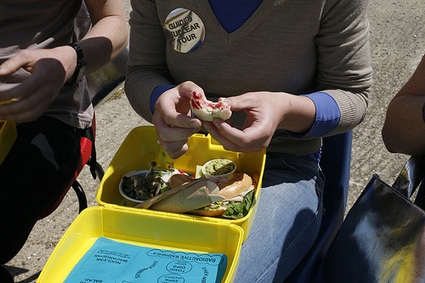 Your research focuses on the UK, did you have a look at what other nations were doing to communicate, promote and roll out nuclear energy?
Your research focuses on the UK, did you have a look at what other nations were doing to communicate, promote and roll out nuclear energy?
Did any of them came up with inspiring strategies and ideas?
My research was based on UK policy, partly because of the immediacy of some of decisions that need to be taken (the Department of Energy and Climate Change was running consultation on the new nuclear power stations at the same time as the beginnings of my project too) and partly because of the re-emergence of nuclear energy as a potential energy source after a long time out in the cold.
My favourite examples of other strategies employed by other countries came from France. This probably stems from France being highly invested in nuclear energy, and it gets over 75% of its electricity this way. A couple of these examples formed the basis for some of my proposals – although I extrapolated them to a farther fetched conclusion.
One was the reporting of the Chernobyl accident in the French press whereby a supposed meteorological anticyclone effect prevented the radioactive cloud from settling, which was discredited more recently. If that story allayed fears about a nuclear accident in France for all that time, then could it be a solution to generate an artificial anticyclone to protect UK inhabitants from this perceived hazard?
The other example I enjoyed was about the channel tunnel. In order to meet CO2 emission reduction targets Eurostar switched is electricity supply from 50% UK 50% France to 100% France. As nuclear energy produces a tiny fraction of the CO2 emissions of the coal and gas-fired power the UK relies on, this slight of hand allowed them to easily meet their target. What if you scaled this up as a policy solution applied to parts of the UK?
I thought these were both fascinating examples, although not necessarily for entirely honorable reasons.
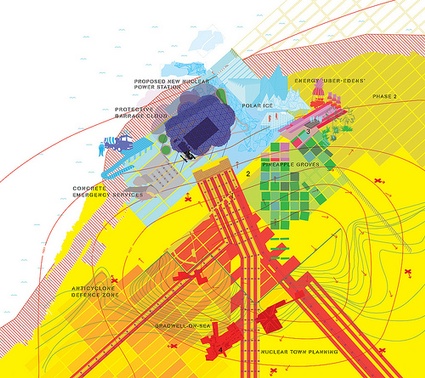 Bradwell Master plan
Bradwell Master plan
A part of your project involved a guided tour of the site of a potential new nuclear power station in Bradwell-on-sea, Essex. Do you know if the inhabitants of the area have a say in the installation of the power station? Did you go around Bradwell-on-sea to ask how people felt about the proposal?
Locally, they are consulted as part of the planning of the Government’s proposed power stations and the local people I spoke to (although not many) were positive about Bradwell producing electricity again. It is a big industry, offering jobs and employment and local prosperity – before the current power station was decommissioned it provided a socio-economic stimulus to this part of Essex.
Interestingly, there were quite a few anti-windfarm stickers in the village protesting the nearby off-shore wind farm. So it’s not that people are undiscerning about their energy supply choices.
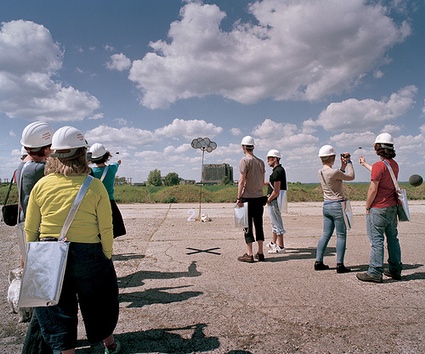 What were the reactions to your project outside of the design sphere? Did you get feedback, invitations, critiques and comments from members of the governments or from scientists?
What were the reactions to your project outside of the design sphere? Did you get feedback, invitations, critiques and comments from members of the governments or from scientists?
My proposals came from 9 months of research and investigation, and were heavily influenced by conversations I had with professionals from the fields of ethics, political science, materials chemistry and the Government’s Department of Energy and Climate Change. Reactions were varied, but these other professional fields are engaging with the topics I was interested in; affecting policy choices and contributing to decision-making.
I think in terms of design, a common question tends to be ‘what did you design?’. I say I designed an argument. Engaging with large-scale policy topics requires negotiating complex issues, getting to grips with them, and finding ways to engage the public in a meaningful debate. I’m keen to take a similar approach to other topics, such as rising sea levels, GM or land use futures (there was an interesting government report issued earlier this year on this).
The practice I established, We Made That, has just been offered an opportunity to take forward a project on energy supply vs. demand – so I think that the approach has a broader value.
I’m a bit puzzled by your idea of a cloud hovering around station. i guess i’m not comfortable with the association between cloud and nuclear. Can you explain me what it would be made of and how it would work?
This was loosely based on the example of the Windscale fire incident; escape of radioactive particles through the containment being breached. Reactors now have containment and passive safety controls. But these are shrouded within a generic shed-type building – the cloud was about us considering a more conspicuous and obvious safety infrastructure. What would it take to convince you that this safety infrastructure was sufficient?
The conversations that stemmed from this proposal were very interesting – especially with the nuclear engineers – about the ‘public understanding of’ reactor safety, and what measures might be most expedient to convince an unsure public. Some of this debate can be seen in the documentary film of the guided tour.
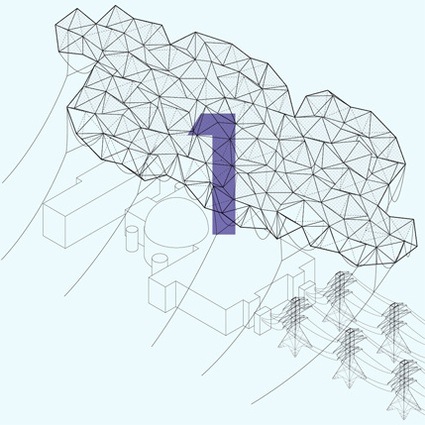 Nuclear is Good, Protective Barrage Cloud
Nuclear is Good, Protective Barrage Cloud
You mentioned that science didn’t quite manage to convince about the benefits of adopting nuclear energy and that a reason for that was that science had to face argument that are “irrational or unscientifically founded”. Can you tell us more about these arguments and why they are unscientifically founded?
Nuclear energy has been around for 60 years in the UK, but now we are at a point of dilemma; looming climate change alters our perspective on energy production. If the scientific arguments put forward are falling on deaf ears then how else can you go about convincing naysayers that difficult choices need to be made? On the guided tour there were both pro-nuclear and anti-nuclear participants – and the argument between them typically came back to;
“It’s very very unlikely, imperceptibly unlikely, that something could get out of all that containment”… “But is that meant to comfort people?”
This reinforces that a shift in tactics or approach might be necessary – although not an admission that science might be very comfortable with.
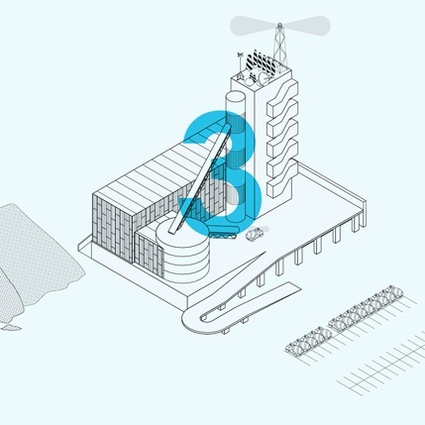 Nuclear is Good, Concrete Emergency Services
Nuclear is Good, Concrete Emergency Services
You will present your work at the sustain 2010 exhibition. Are you going to present the project in the exact same way you did at the Summer show? Or has the content of your project or the way you communicate it changed over the past few weeks/months?
I’ll actually be showing the project differently. I imagine it will remain fairly provocative in terms of sustainability, nuclear tends to be a divisive topic, but the implications of our energy choices still need to be addressed. Setting these energy choices against climate change leads to difficult questions.
I personally consider nuclear to be necessary as part of an eco-pragmatic energy agenda. My approach to the project considered nuclear the ‘what if’, but there’s also a ‘what if not?’ choice available to us – but maybe this is less palatable than the nuclear option. As you might be able to tell, I question whether it is genuinely ‘sustainable’ to continue making more ‘sustainable products’ – and I would rather address the fundamentals at the root of our energy choices.
Thanks Oliver!

